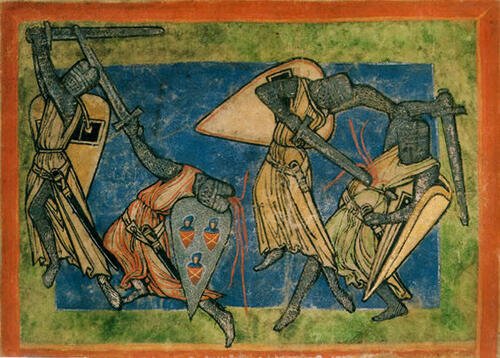I Get Knocked Down, But I Get Up Again
It only takes a few typical D&D combats before you realize that it rarely makes tactical sense to heal an ally until they really need it. A combatant is just as capable while at full health as they are at death’s doorstep. And once they are downed, you just need to heal them the bare minimum for them to be right back in it. This leads to the binary state between dead (or in more modern D&Ds, dying) and alive as the only important consideration.
Despite the ubiquity of this dynamic, there are two common criticisms leveled against it, mostly from opposite camps. For some, this dynamic is anathema simply because it is unrealistic (note: I have already made my thoughts on realism clear, in my own opaque way). If you are covered in cuts, bruises and torn ACLs, you are likely to be less effective in your efforts to kick the ever-loving shit out of your opponent. I find the argument from realism a bit weak simply because of how nebulous hit points are in what they represent; as Philotomy famously mused, “hit points are an abstract measure of a PC's well-being and fitness for combat” rather than representing literal physical injuries. The other complaint is basically that the current dynamic of binary hit points leads to fewer interesting tactical decisions. It is almost always better to wait until the last minute (or even a few seconds thereafter) to heal someone, and there isn’t much benefit to being proactive. Everything is more interesting when there isn’t an obviously correct answer.
Below are a few options for “solving” this “problem,” along with some examples from games:
Healing Is Hard
Under standard D&D, you might be lying dead on the street, then when you regain a single hit point, you are immediately ready to rejoin the fray. But with this alternative, you have to be healed well past the 0 hp threshold to get back in fighting shape. One game that takes this approach is Trespasser, which is currently available in playtest form. In Trespasser, you must regain at least 10 hp after falling to 0 before you can regain consciousness and/or the fight. This means that, if you have a character with only a few hit points remaining, it may make more sense, depending on the situation, to be proactive.
Healing Is Slow
This method basically penalizes getting down to 0 hp such that it isn’t a viable strategy to wait and heal an ally only after they are downed by making it take so much time to regain consciousness that the battle is likely over once they come to their senses. Low Fantasy Gaming provides an example of this method in which the spell Fusing of Flesh will revive a downed character over the course of 1d3 minutes. So it is better to cast the spell while they are still on their feet so that they can get the benefits of healing immediately. This is not my favorite solution because, just like the initial problem, it means that there is basically always a correct solution; there is almost no situation in which it would make sense to heal a downed character in the middle of combat.
Spectrum of Injuries
This method is more likely to mollify those who detest binary hit points because they are unrealistic. However, my example is a game without hit points: Blades in the Dark. In Blades, you basically have injury slots, and filling the slots causes your character to be less effective. Blades is a really fantastic and elegant system, so there are a lot of other parts of the game that interlink, but most important for our purposes is the fact that each injury has drawbacks, not just a binary on-off switch for the player’s consciousness. This could also work with hp by assigning effects to hp thresholds: At 70% or fewer hp, your movement is halved; at 30% or fewer hp, your attacks and spells are made at disadvantage; at 0% hp, you need to be healed ASAP or you’ll die. Just as an example.
Some Injuries Linger
Prismatic Wasteland (or at least the current version, v0.3) has 2 injury tracks: it has Grit, which is basically hp by another name and it has Stress (unrelated to Stress from Blades in the Dark), which represent the more long-lasting impacts of combat and other failures. The key difference is that Grit returns after a night’s rest and you get more Grit as you level up, but there are only ever 4 levels of Stress and it takes a week’s rest to recover one level. The various levels of Stress have progressively worse impacts on the character’s performance (similar to the Spectrum of Injuries example), but the more important aspect is how long it takes to heal Stress. If you get to the third level of Stress, you may have to take nearly a month off of adventuring to heal. This is partially due to scale: Prismatic Wasteland is about long journeys through the wasteland and operates at a longer time scale than most other D&Ds. But it is also a disincentive. You do not want to get Stress, so you better keep an eye on your Grit. When you hit 0 Grit, you can keep fighting, but each attack against you will increase your Stress by 1. That is not a good situation to be in, but there is a choice for the player. Will you risk it?




